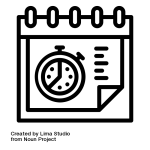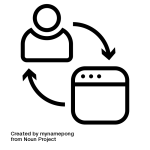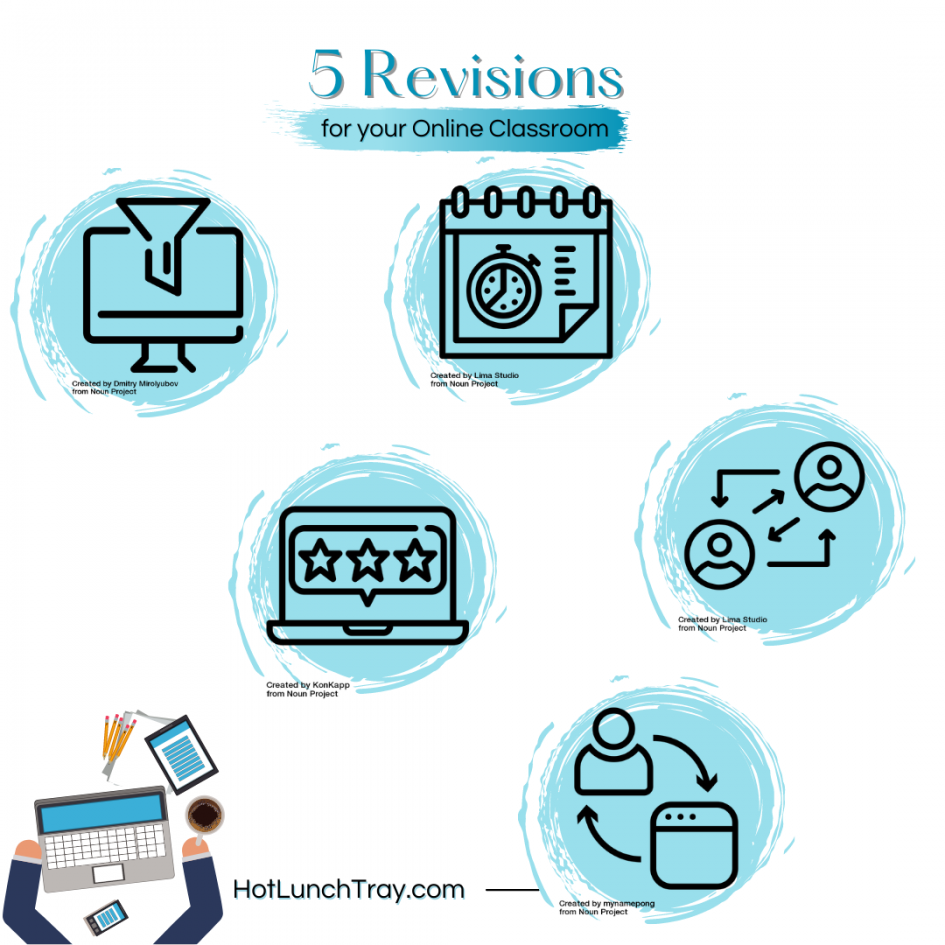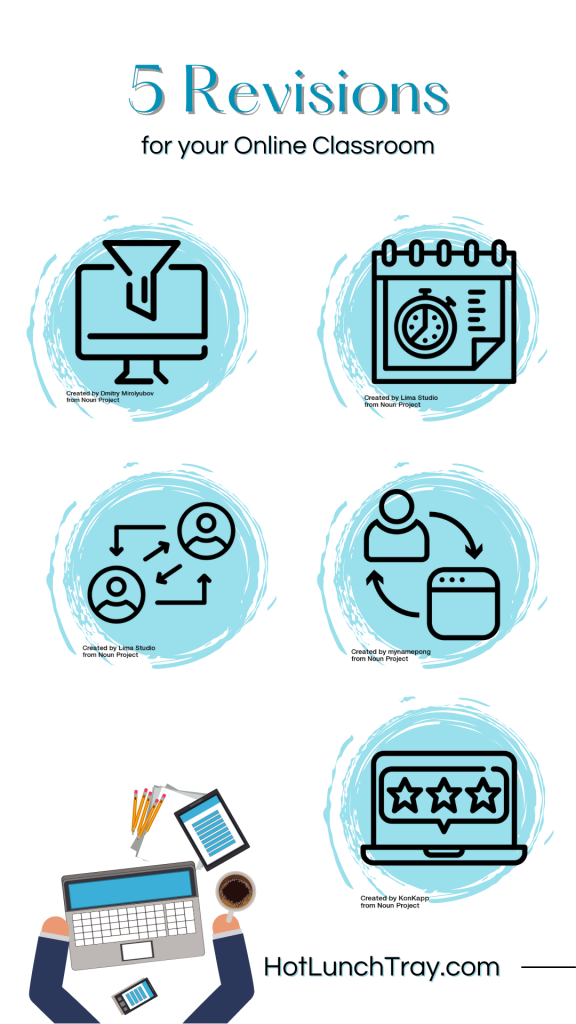Now that you have an online classroom how should you improve it? Here are 5 revisions for your online classroom. These suggestions will create a better learning experience for your participants.
Format Singularity

Courses are often assembled from the point of view of one subject matter expert. Consideration should be extended to how the participants experience the content, across the curriculum. The decision to consolidate the end-user experience into one format is an important one for the organizational unit (district/school). It allows messaging of expectations, allows supporting family members a chance to helpfully support the teachers.
The first decision is often document format, Microsoft Word or Google Documents? Some districts find Microsoft formats more secure because the sharing feature is more intentional; security may be a legitimate concern for K-12 student’s privacy needs for education accommodations, remediation, or diagnosis. Regardless of the format, consider embedding as well and allowing for the download of all documents shared for accessibility purposes; embedding alone does not work with all screen readers. Pro Tip: do not upload a PowerPoint file for example, but save it as a PDF and then upload it to reduce course size and load times.
After a consistent format is established, consider how participants receive and submit documents. Many educational organizations have a preferred learning management system (LMS). If your organization uses an LMS use that to disseminate and collect documents. Teachers may have used a variety of tools from Emergency Remote learning through Pandemic Teaching. Gain consensus on tools such as Kami versus Google Assignments for use within your LMS and ask all teachers to commit to that format for ease of use for the participants and any support systems they have.
The most important consideration is the end-user, is it clear to them what to expect in their courses? Microsoft Word or Google Docs? How do they submit work to their teachers? And most importantly, is the answer the same regardless of the course subject?
Time Management
 I love a good planbook, but the writing of lessons is only one small facet of time management. Once the macro plans of the year, semester, units are done how does an online teacher manage time? A Pacing Chart can often break down units into weekly plans. A pacing chart can also offer participants and their support teams a touchpoint for on-pace activities in your online class. Happy teachers make happy classrooms; institute at least this revision from the 5 revisions for your online classroom.
I love a good planbook, but the writing of lessons is only one small facet of time management. Once the macro plans of the year, semester, units are done how does an online teacher manage time? A Pacing Chart can often break down units into weekly plans. A pacing chart can also offer participants and their support teams a touchpoint for on-pace activities in your online class. Happy teachers make happy classrooms; institute at least this revision from the 5 revisions for your online classroom.
In order to take charge of managing your own time and not let tasks run you respond to each item in turn and at specified times. If you respond to each email coming in you do two things, you allow recency to replace urgency and you train parents and colleagues to expect an immediate answer. Email is not for an immediate answer, tools such as Slack and Teams are for that and should not be used as often as email.
{READ: Email Hacks for Teacher Efficiency}
Being online teaching is different than being in a face-to-face classroom. While the bell schedule dictates when a teacher checks email, the online teacher can set the schedule for checking email. Consider the times you are willing to commit to checking email. Talk with your online teaching colleagues to assure consistency between each other. I suggest posting when parents/colleagues can expect you to read and respond to emails.
Submissions
Just as it would not be productive to respond to every email as it comes in, it is not an effective use of an online teacher’s time to grade every submission as it comes in either. The expectations of the submission can guide the teacher’s response. While discussion posts are often not to be graded along the way, monitoring the trend of the post topics may be helpful in reinforcing or refocussing the discussion. If a teacher has an ongoing discussion a good range to consider checking the discussion board would be once a day to once per hour given the level of interaction on the post. Online discussion posts remain the place for discourse between peers, not another place for a teacher lecture; teacher presence can be projected in other ways.
It is typically more efficient for teachers to check submitted assignments all at once. Do not check assignments one at a time as they come in, but instead monitor the channels participants have for questions on assignments, maybe look at the first couple to assure directions were clear enough, and then wait until after the due date to grade. While there may still be those who have to turn the assignment in, you can remind them of the due date while you start grading. Ideally, the assignment has a rubric for precise grading and the teacher of record provides additional feedback (see Feedback for Students).
Top of the hour for email check, the bottom of the hour post checks, and x-number hours/days after the due date for submission checks during school hours/non-synchronous times.
Communication
 Communication was revealed to be an important part of what K-12 education does during the Remote Emergency learning into Pandemic Teaching. Generally, K-12 discovered the previous over-reliance on face-to-face communication necessitated new communication processes. This revision is the most important of the 5 revisions for your online classroom as communication affects everyone for the duration of the class.
Communication was revealed to be an important part of what K-12 education does during the Remote Emergency learning into Pandemic Teaching. Generally, K-12 discovered the previous over-reliance on face-to-face communication necessitated new communication processes. This revision is the most important of the 5 revisions for your online classroom as communication affects everyone for the duration of the class.
Participants and Stakeholders
As the online teacher, the goal should be to broadcast the same message on multiple channels, allowing participants/their families receive communication via their preferred channel. The message discipline required to maintain the same message across platforms and within tight time frames is what can make communication effective. If messages vary some stakeholders will receive better/worse information than others. If the timing between platforms lags, some stakeholders will receive information before/after other stakeholders. When either of those happens the recipients tend to blame the teacher; avoid that by scheduling adequate time to schedule/create all messages and the copy/paste into each platform to send as immediately and close together as possible.
Various platforms, such as an LMS, may have ways to communicate only to students or to both students and families. Be aware of these differences and to whom you are communicating with each message. Consider creating a communication log for each student and include mass communications as well as individual communications.
{READ: Communications Across Modalities}
Colleagues
How was your email inbox from Remote Emergency learning forward? That’s because email is not how we should be communicating with our colleagues. Consider using Slack or Teams as a way to communicate quickly with your content, grade level, school, or district stakeholders. Your district may already have Teams as part of a district purchase from Microsoft. This teacher-only tool is used for communication between grade-level members, subject area members, or schools. Consider the wide variety of tutorial options offered by Microsoft or drill in with a Microsoft Teams for Dummies book.
Interactions
 Even though a class is an online class it should feel as if there is a classroom culture. You don’t get culture from a correspondence course. It is essential to structure learning events that foster collaboration. Plan for a balance of instructor-initiated and participant-initiated activities.
Even though a class is an online class it should feel as if there is a classroom culture. You don’t get culture from a correspondence course. It is essential to structure learning events that foster collaboration. Plan for a balance of instructor-initiated and participant-initiated activities.
Video Conferencing
The format (Zoom, Teams, WebEx, Adobe Connect) does not matter, but synchronous video calls helped most K-12 classrooms through the pandemic. But in the spirit of revisions, consider how to make those sessions more focused and productive. If you are tempted to replicate the experiences of the pandemic, think again. As an instructor, you can use that time better now. Allow the live video time for guided practice sessions, question and answer sessions, catch-up sessions for the student. Instead of time where you are delivering live/synchronous (unrewindable) instruction think about all the other things you did with your students in smaller settings and make yourself available for those work sessions online.
If the video conference is to be a synchronous lecture/lesson delivery, consider the following upgrades. Check your preconceptions about if students are paying attention (Trust, 2020) during your online lectures. Remember that the K-12 participants are used to watching YouTubers – you are not a YouTuber – however, you can use some YouTuber Principles (Trust, 2020). Video conferencing is not the only way to virtually interact.
{READ: Zoomed Out & get the FREE eBook}
Interactive Opportunities
Many activities from the classroom where students interact with content or each other can be replicated online. While a lecture is best a stand-alone recording it is particularly awesome for structuring a notetaking session for participants. The instructor can signal where s/he is in the notes and allow the participant to “rewind” the lecture. Cornell Notes allow students to interact with a lecture and take notes with the idea to produce a summary at the conclusion of the interaction. You can use this Google Doc template for Cornell Notes and Force a Copy to your students.
Collaboration is defined as students working jointly on the same work product rather than individually on different components of the same assignments (Stephens & Roberts, 2017).
Collaboration is not always the right way to learn or teach. Students (and teachers) are not always ready for collaboration; instructional scaffolding needs to be in place to understand the roles and expectations of positive collaboration. Teachers often work up to a true collaboration assignment/project and then support groups and individual members throughout the collaboration. Collaboration may be seen by some as “cheating,” but students may not understand how to learn with technology while avoiding unintended plagiarism (Shaw, 2021). Educators need to educate students on how to learn with technology while upgrading the learning opportunities online for students.
Moore (2012) lists options which, more experienced, institutes of higher learning use: an academic honor code that applies both online and face-to-face. Intellectual property rights for faculty is preserved in different ways in higher education and should be considered for K-12 as it inspires more creative content from instructional design processes.
Feedback for Students
 There are several types of feedback for K-12 participants. Feedback can be assignment-specific (rubrics) or student-assignment specific (teacher commentary on a student assignment submission). Finally, a teacher could be academically intervening.
There are several types of feedback for K-12 participants. Feedback can be assignment-specific (rubrics) or student-assignment specific (teacher commentary on a student assignment submission). Finally, a teacher could be academically intervening.
Rubric-based Feedback
Doing the front-end-loading of adding detailed rubrics to all submissions is a productive step. It encourages the participants to look ahead and better understand what is required. Typically a rubric increases the pace of grading and assures more equitable scoring. There may be efficiencies for rubric creation. Consider writing one rubric for all submission types, like discussion board submissions. A well-crafted rubric can also guide students into consistent submissions if the rubric criteria are specific.
Teachers could also work across subjects to create uniform rubric criteria. Consider gathering similar disciplines under one rubric. If students encounter similar expectations in multiple disciplines submissions should elevate and be more consistent.
Teacher Commentary
Just as rubrics can preventatively correct students submissions, teacher commentary on student submissions is highly effective in students learning with an effect size of .7 (Visible Learning, 2017 ). When providing feedback, use the student’s name, be specific and refer to the rubric and the submission as possible. Consider the powerful act of video feedback as it allows more subtle communications, not just for the teacher’s voice, but use fo annotation as well.
Instructors can often predict the feedback needed per submission(s). Coupled with the use of a rubric, instructors could craft some starter commentary. I recommend a Google Sheet (ideally shared between instructors of the same content/assignments) where the work of submission commentary can be divided, improved upon, and added to overtime. Just as using a student’s name increases engagement, so does the use of emojis. Emojis from emojipedia.org can be added to a Google Sheet and then copied/pasted into the learning management system (LMS) space for feedback
{READ: this post on how I copy/pasted feedback}
Academic Intervention
When participants struggle, the instructor needs to know and act just in time. Use this progression of escalating feedback: Request a synchronous meeting with the student first. Let the student know about the concern, maybe there is an alternate explanation the student can share. If the issue escalates or continues involve the family support system in the next contact and reference the previous contact. If further intervention is required, referring to your communication log (which should include all prior contacts) reach out to your administrator or support person to help with the next level of contact.
Are there other ways you are upgrading your online classrooms?
References
Backup of Hattie’s Ranking list of 256 Influences And Effect Sizes Related To Student Achievement. VISIBLE LEARNING. (2017). https://visible-learning.org/backup-hattie-ranking-256-effects-2017/ (Links to an external site.).
Moore, J. C. (2012). A Synthesis of Sloan-C Effective Practices, December 2011. Journal of Asynchronous Learning Networks, 16(1), 91–115.
Shaw, A. (2021). Teaching or cheating? Using collaboration and technology to support student learning. International Journal on E-Learning, 20(1), 47-58. https://www.learntechlib.org/primary/p/215594/.
Stephens, G. E., & Roberts, K. L. (2017). Facilitating Collaboration in Online Groups. Journal of Educators Online, 14(1), 20–35.
Trust, T. (2020). Rethinking Teaching 2020. Torrey Trust, Ph.D. https://www.torreytrust.com/projects.







2023-09-13 at 11:53 pm
Your comprehensive guide to improving the online classroom experience is incredibly valuable. Addressing format, time management, communication, interactive opportunities, and feedback enhances both teachers’ and students’ online learning journey. Thanks for sharing these essential revisions!